The recent revelations about crows challenge long-standing assumptions regarding animal intelligence. Traditionally, humans have prided themselves on possessing cognitive abilities that set them apart from the animal kingdom. However, a groundbreaking study has unveiled crows’ profound geometric intuition, blurring the lines we draw concerning intelligence across species. It’s a wake-up call—a compelling reminder that intelligence may not be as exclusive to humans as we have arrogantly believed.
The research conducted by a team of scientists led by Andreas Nieder at the University of Tübingen dives deep into the world of geometry as experienced by these feathered intellects. If you think of crows merely as scavengers, you will be surprised to know they wield an intellect that allows them to identify geometric shapes like squares and rectangles with the same acuity that humans possess. This should prompt a crucial reevaluation of how we approach and even engage with other species.
Questioning Our Cognitive Supremacy
The study’s findings reframe the established narrative of cognitive supremacy. By demonstrating that crows can not only detect geometric regularities but actively utilize these skills to thrive in their environment, a rich tapestry of intelligence unfurls. Crows’ abilities to discern the ‘odd one out’ in a set of geometric shapes suggest something far more intricate—a potential evolutionary underpinning that we are only beginning to understand. We may have to reconsider our self-imposed ego that places humanity on a pedestal far above our avian counterparts.
This does not merely suggest that crows are smart; it forces us to confront an uncomfortable truth: Intelligence is multifaceted and exists in various forms throughout the biosphere. The capacity for geometric recognition should prompt us to reflect on our own limitations. Just because we may have developed complex mathematical theories doesn’t negate the fact that visual-spatial reasoning is deeply embedded in many organisms, crows included.
Ethics of Animal Treatment
These revelations, rooted in scientific inquiry, compel us to rethink how we treat and relate to these sentient beings. Crows’ demonstrated abilities open the door for further exploration into the ethical implications of our relationship with animals. If creatures capable of complex cognitive tasks—like detecting geometric anomalies—deserve our respect, what does this mean for practices that exploit or disregard animal welfare?
It should incite urgency within us to advocate for policies that prioritize understanding animal intelligence and welfare in ways that are often neglected. As we stand at the crossroads of science and ethics, the growing acknowledgment of animal intelligence, particularly among crows, should galvanize action against outdated perceptions that render animals as mere tools for human benefit.
Nature’s Complex Designs
Crows learning to detect geometric shapes hints at a broader significance of geometric regularity in the animal kingdom. It indicates a collaborative co-evolution between species. Animals do not merely react to their environments—they interact with intricacies that reveal an underlying intelligence that links species. Perhaps, as we learn more, this will testify to the intricate ways through which all beings have adapted to their surroundings.
The acknowledgment that intelligence can be diverse challenges our rigid categorization of animals in hierarchies of intelligence. The edges of species lines blur, suggesting that the aptitude for complex reasoning and pattern recognition might be widespread—not solely a human attribute.
Crows: The Unlikely Protagonists
These sober findings shine a light on why crows should be celebrated rather than cast aside as mere nuisances. Our society’s perception of them needs to shift; they are not just messengers of doom or scavengers that feed on our waste. They embody a form of intelligence that is both nuanced and deeply fascinating.
By understanding these birds as the unlikely protagonists in the narrative of intelligence, we unlock a perspective that challenges us to rethink our role within the larger community of Earth’s inhabitants. The crows—symbols of adaptability and intelligence—remind us, in their unique ways, that we are all part of a connected ecological system worthy of awe and respect.

